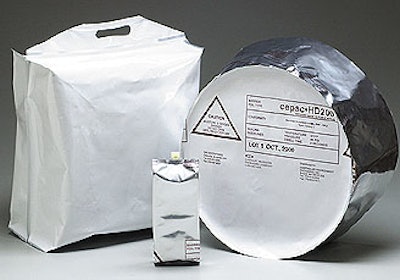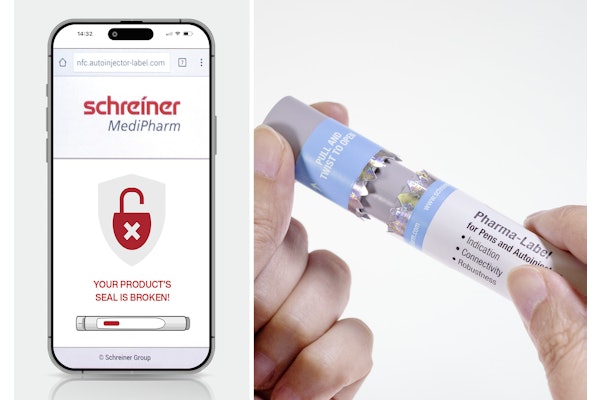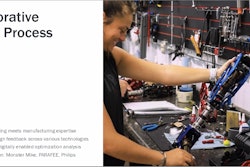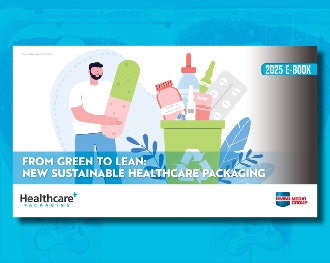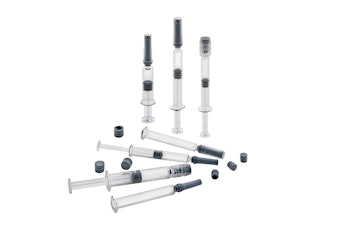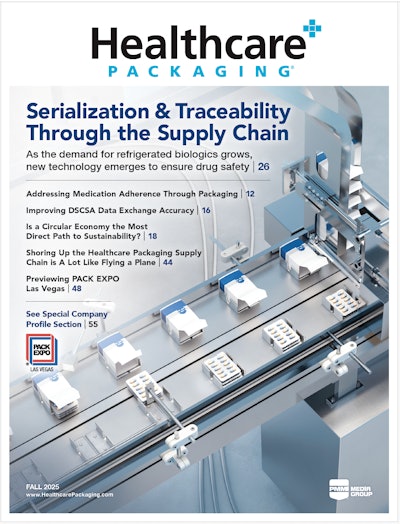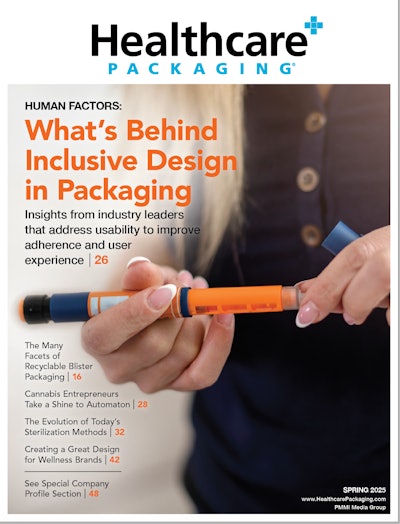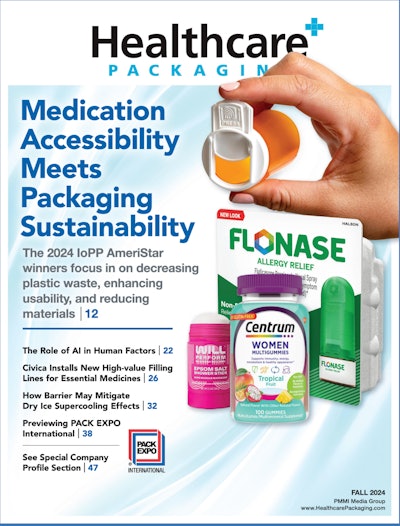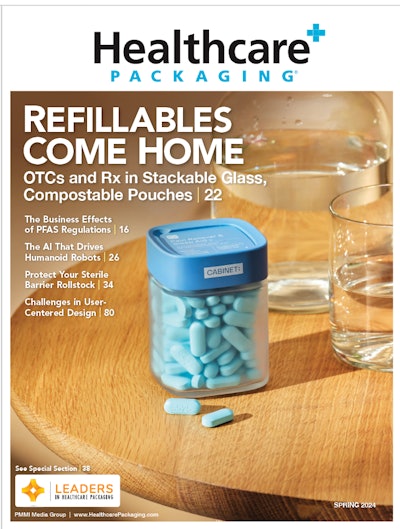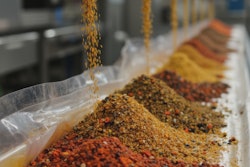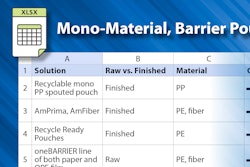Non-food structures are often among the most intriguing and unusual packages to earn converters and manufacturers recognition from the Flexible Packaging Assn. (Linthicum, MD). That was again the case at FPA’s Flexible Packaging Achievement Awards 2000, which were announced March 1, 2001. (Food packages winning FPA awards are covered in stories on p. 34 and p. 41.)
One of the association’s two Highest Achievement Awards, for example, went to the cepac® HD Series, a flexible “wrap” from Cadillac Products Packaging (Troy, MI). As the accompanying photo shows, cepac can be used to replace rigid structures for various package configurations (1). However, FPA recognized it as a material to protect products such as military aircraft engines in storage, or welding rods and wire used in industrial applications.
The HD100 structure, from the outside-in, is a multi-layer lamination that includes biaxially oriented nylon/polyethylene/foil/PE/coextruded PE. Total thickness is between 8 and 8.5 mils. HD200 is a 12-mil structure that includes biaxially oriented nylon/PE/cross-laminated high-density PE/PE/foil/coextruded PE. The 3-mil cross-laminated layer is a Valéron® film from Valéron Strength Films (Houston, TX), formerly Van Leer Flexibles.
Cepac was developed and trademarked by Controlled Environment Packaging (Buford, GA). Cadillac makes the flexible structure, sending rollstock to fabricator Heritage Packaging (Fairport, NY). Heritage converts the rollstock into the final end-use package, be it a bag, cover, or pouch.
According to Leon Jensen, chief executive of Controlled Environment Packaging, Lockheed is one of the end-use companies using this award-winning material, for aircraft engine and exhaust covers. The structure provides tear and puncture-resistance, as well as strong oxygen and moisture barrier.
According to Cadillac, a valve is installed into the material to allow nitrogen flushing that helps maintain environmental conditions inside the wrap.
In one application, the material replaced a previous preservation method whereby aircraft components had to be cleaned, wrapped in layers of corrosive-inhibitor paper or film, then placed in boxes. The change to the wrap, Cadillac maintains, helped reduce the time it took to preserve an entire aircraft by 160 hours. It also lowered material weight by 705 lb, and saved $4ꯠ.
CR and easy to open
FPA gave a Gold award to the Medi CRREO pouch (2), developed by Pactech (Rochester, NY). Its development and usage was hastened by the U.S. Consumer Products Safety Commission, which played a key role in leading to a federal requirement that all clinical trial drugs be packaged in a child-resistant container by late November 2000.
Sanofi-Synthelabo of Malvern, PA, is the pharmaceutical research firm that worked with Pactech to become the first user of the Medi CRREO pouch. Sanofi-Synthelabo puts a non-CR blister pack inside the CR pouch.
“We specified that we wanted it to be a clear pouch so that [the patient] can see the contents, and to eliminate the need for any labeling on the blister card,” says Ed Suez, manager, clinical investigational products.
Sanofi began using the pouches last November, in 12”Wx8”H and 10”Wx7”H sizes. Suez says one blister pack is typically placed in each pouch, with the blister containing between 10 and 60 individual capsules or tablets. Pouches are shipped to physicians, hospitals, and contract research organizations for clinical trials or “product investigations.”
Pactech president R. David Diederich describes the pouch structure as a five-layer, 6.5-mil extrusion lamination. Some of the material, he says, is proprietary. He does credit Valéron Strength Films (Houston, TX), with supplying its 2.5-mil Valtuff™ cross-laminated high-density PE film. That film is part of a structure that also includes an outer layer of nylon that provides heat-seal resistance and strength. Pactech reverse-flexo-prints the nylon in black, with information on how to use the CR pouch.
A patented sliding zipper, supplied by Minigrip/Zip-Pak (Manteno, IL), is applied to one inside dimension of the pouch. The LDPE zipper works much like a zipper on clothing. Suez explains, “When you go to open it, you press both ends down like a clothespin. That releases the zipper from the mechanism and allows you to slide it. To resecure it, you slide the zipper back and then press it back in place.” The injection-molded polypropylene clothespin-like device is supplied by Convey (Euless, TX).
While the pouch does not provide an air-tight or moisture-resistant structure, it does resist access by children. Eventually, Suez admits, “we’ll have to make our primary packaging child-resistant as well.”
Pactech’s Diederich says that since Sanofi-Synthelabo began using the pouch, the regulations have led to applications with at least 40 other end-use customers.
Formable foil
A new medical package configuration for San Diego-based Biosite Diagnostic’s Triage Cardiac System (3) earned an FPA Gold for Rollprint Packaging Products (Addison, IL). The package includes a peelable top web that’s heat-sealed to a cold-formed foil bottom web.
Rollprint refers to the bottom web as its FlexForm™F material. Approximately 3.5-mils thick, it includes an adhesive lamination of 60-ga nylon/0.002 foil, which then receives a coextrusion-coated sealant layer that Rollprint will only identify as a “polyethylene copolymer.” The top web consists of polyester/white adhesive/0.001 foil/2-mil multilayer peelable sealant. Total thickness is about the same as the bottom web. The material is laminated by Cello-Foil Products (Battle Creek, MI).
Karen Berger, Rollprint’s development manager, tells Packaging World that “the forming process stresses the foil, so it’s critical to use the proper choice of foil and adhesive to prevent the foil from cracking or delaminating. The structure used by Biosite has a strong oxygen barrier and excellent moisture barrier.” While she did not have specific figures for the forming web’s oxygen transmission rate or moisture vapor transmission rate, the top web’s OTR is 0.000cc/100 sq”/24 hr; MVTR is 0.00g/100 sq”/24 hr.
The barrier properties are critical because exposure to oxygen or moisture is detrimental to Biosite’s product, which is a test kit used in detecting heart attacks. The kit provides “a quantitative diagnostic test in the emergency room,” says Matt McDermott, Biosite’s senior development engineer.
The package, McDermott says, will likely be available in the second quarter of this year, replacing a premade pouch that’s been used for about 1½ years. Biosite will produce the package with a new CP-3 machine from Klöckner Medipak (Clearwater, FL). The bottom web will be cold-formed on the CP-3, using pressure rather than heat to form the two “protrusions” that create three product-holding cavities in the stucture. The machine produces the new package in a three-up configuration across the web. After the cardiac device is added into the cavities, the lidding material is heat-sealed to the bottom web.
As the lidding web unwinds towards the filled bottom web, three pressure-sensitive humidity absorber “labels” are applied to the underside of the web. “These are custom-made for us,” says McDermott, by Multisorb Technologies (Buffalo, NY). “We can’t have oxygen or moisture inside the package,” he states. After lidding, a die cuts the material into individual trays, which are stored at room temperature for a short period in a curing process “that allows the reagents to completely dry,” McDermott explains. Packs are not sterilized.
The Triage system has been “well accepted in the market,” says McDermott, who indicates that its strong test results gave Biosite confidence to replace the pouch with the new package design. And for Biosite, the new package offers considerable benefits compared to the pouch.
“The [pre-made] pouch was an easy way to test the product in low-production runs,” notes McDermott. But for a more widespread launch, he suggests, “there has to be a better way to do it.” He says the tray is smaller than the premade pouch, so Biosite will reduce the size of the carton that holds 25 test kits by two-thirds.
“And because it’s smaller, we’ll be able to reduce the amount of storage space we need. We store product here and pay a distributor for storage space, so there will be a financial savings from that,” he points out. Based on producing about 3 million of the new packs per year, he says “my original estimate of cost savings was $250ꯠ a year in raw materials alone.”
The new package is so promising that Biosite plans to use it with a new kit to test for congestive heart failure, McDermott tells PW.
Header bag posts savings
Another non-food FPA award went to an all-plastic “header bag” that replaced a blister/paperboard card structure for more than 30 of 3M’s Post-it Flags (4). Earning a Silver award, the material is supplied by North State Flexibles (Greensboro, NC). The 2-mil structure is an adhesive-lamination of two layers of 1-mil cast polypropylene film, with one layer reverse-flexo-printed in eight colors. A 6-mil clear PP header reinforcement is used at the top of the package, with a hang hole cut into the area for retail display.
“We began using this structure in early 2000,” says Jim Dame, operations manager for 3M’s Stationery and Office Supplies Division, St. Paul, MN. “We saw an opportunity to reduce material costs, and we were redesigning our Post-It Flag line so we wanted the packaging to give us a stronger retail presence.”
He says the Flags have been on the market for about 10 years at retail stores and wholesale office supply firms. The combination of product reformulations and new packaging have helped 3M achieve cost savings and strengthen its shelf presence.
Dame estimates economic savings will reach 20% by the end of this year as volumes increase. “And the material gives us excellent clarity and allows the package/product to stand out from among the sea of blisters on the market. It’s especially beneficial from an environmental perception standpoint in our European market, which was part of our global brand strategy. We ship a significant amount of product to that fast-growing market.”
Standing up to spills
Two additional non-food FPA winners were packages containing cleaning products. Last summer, Lompoc, CA-based Advanced Minerals introduced a powdered product called Spill Doctor (5) sold in ¾-, 5- and 10-lb varieties. The pouches are sold at retail and in industrial environments. The package won FPA’s Member’s Choice award.
Kim Rivera, Advanced Mineral’s manager of retail products, explains, “When we exhibit at trade shows, it’s the package that gains everyone’s attention.” FPA judges liked the package, too, giving it a Silver award. Supplied by Smurfit-Stone Container Flexible Packaging (Schaumburg, IL), the pouches are made of 48-ga polyester adhesive-laminated to 4.5-mil linear-low-density PE. The polyester is reverse-printed in six colors flexographically.
According to Smurfit’s sales and marketing executive Bob Shatney, the converter applies a zipper from Minigrip/Zip-Pak (Manteno, IL) in line on a relatively new machine from Totani, distributed in the United States by Amplas (Green Bay, WI). Premade zippered pouches are shipped to Advanced Minerals’ plant in Texas.
Pouches are filled with the powder, which is an absorbent that is spread onto a spill and later swept up. “So if a glass jar of pickles breaks in the supermarket aisle, a worker could dispense Spill Doctor onto it and once the liquid is absorbed, just sweep it up.”
To the best of Rivera’s knowledge, most competitive products are sold in multiwall bags or paperboard cartons. The stand-up pouch is said to provide reclosability, cost effectiveness, and a strong shelf presence due to its graphics and “billboard” space.
Advanced Minerals is in the process of rolling out the pouches nationwide, with distribution plans for auto, hardware, and home improvement stores. “It’s selling very well,” Rivera acknowledges, “and people love the packaging.”
Label extends info space
Like Advanced Minerals, San Diego-based Motsenbocker Advanced Developments also markets cleaning products in packaging that earned a Silver award from the FPA. In this instance, the award went to an Extended text Easy Tab™ label from Ampersand Label (Garden Grove, CA).
Unlike some extended-text labels that pull out like an accordion, this label incorporates an adhesive-reinforced pull tab that allows the product user to open the label and read it like a booklet.
The label is used for five different cleaning products used in the home or in industrial applications, says company COO Skip Motsenbocker. “We began using these last November for our Canadian market to meet mandatory information requirements for product information and to carry information in both French and English,” he tells PW. He believes the label will be used for packaging sold in the United States, “within a year, to provide additional information.”
For the three-pack of 2-oz bottles unified by a reclosable vinyl bag (6), the label is applied to the vinyl. This label includes a 40# paper release liner/pressure-sensitive adhesive/two layers of 60# coated paper printed on both sides/PP.
What makes the approximately 12-mil structure so unusual, according to Ampersand Label president Lowell Matthews, is that it’s produced in a single pass on a flexographic label press that is equipped with “turn bars” that permit the two-sided printing.
The result is that this single label contains five panels of information. “There are considerable details we can provide with this label,” says Motsenbocker. These could include “certain Canadian requirements, including product details, size, place, and name of the manufacturer, any necessary warning statements, and copy in both French and English.
